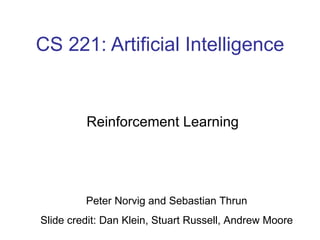Melden
Teilen

Empfohlen
Integration of informal economic cross-border networks in West Africa

Integration of informal economic cross-border networks in West AfricaSahel and West Africa Club (SWAC/OECD)
Weitere ähnliche Inhalte
Andere mochten auch
Integration of informal economic cross-border networks in West Africa

Integration of informal economic cross-border networks in West AfricaSahel and West Africa Club (SWAC/OECD)
Andere mochten auch (20)
Integration of informal economic cross-border networks in West Africa

Integration of informal economic cross-border networks in West Africa
Ähnlich wie Cs221 rl
Ähnlich wie Cs221 rl (20)
anintroductiontoreinforcementlearning-180912151720.pdf

anintroductiontoreinforcementlearning-180912151720.pdf
Mehr von darwinrlo
Mehr von darwinrlo (9)
Kürzlich hochgeladen
Kürzlich hochgeladen (20)
From Event to Action: Accelerate Your Decision Making with Real-Time Automation

From Event to Action: Accelerate Your Decision Making with Real-Time Automation
Beyond Boundaries: Leveraging No-Code Solutions for Industry Innovation

Beyond Boundaries: Leveraging No-Code Solutions for Industry Innovation
The 7 Things I Know About Cyber Security After 25 Years | April 2024

The 7 Things I Know About Cyber Security After 25 Years | April 2024
How to Troubleshoot Apps for the Modern Connected Worker

How to Troubleshoot Apps for the Modern Connected Worker
Swan(sea) Song – personal research during my six years at Swansea ... and bey...

Swan(sea) Song – personal research during my six years at Swansea ... and bey...
The Codex of Business Writing Software for Real-World Solutions 2.pptx

The Codex of Business Writing Software for Real-World Solutions 2.pptx
WhatsApp 9892124323 ✓Call Girls In Kalyan ( Mumbai ) secure service

WhatsApp 9892124323 ✓Call Girls In Kalyan ( Mumbai ) secure service
How to Remove Document Management Hurdles with X-Docs?

How to Remove Document Management Hurdles with X-Docs?
SQL Database Design For Developers at php[tek] 2024![SQL Database Design For Developers at php[tek] 2024](data:image/gif;base64,R0lGODlhAQABAIAAAAAAAP///yH5BAEAAAAALAAAAAABAAEAAAIBRAA7)
![SQL Database Design For Developers at php[tek] 2024](data:image/gif;base64,R0lGODlhAQABAIAAAAAAAP///yH5BAEAAAAALAAAAAABAAEAAAIBRAA7)
SQL Database Design For Developers at php[tek] 2024
IAC 2024 - IA Fast Track to Search Focused AI Solutions

IAC 2024 - IA Fast Track to Search Focused AI Solutions
Transcript: #StandardsGoals for 2024: What’s new for BISAC - Tech Forum 2024

Transcript: #StandardsGoals for 2024: What’s new for BISAC - Tech Forum 2024
Injustice - Developers Among Us (SciFiDevCon 2024)

Injustice - Developers Among Us (SciFiDevCon 2024)
Human Factors of XR: Using Human Factors to Design XR Systems

Human Factors of XR: Using Human Factors to Design XR Systems
Azure Monitor & Application Insight to monitor Infrastructure & Application

Azure Monitor & Application Insight to monitor Infrastructure & Application
Neo4j - How KGs are shaping the future of Generative AI at AWS Summit London ...

Neo4j - How KGs are shaping the future of Generative AI at AWS Summit London ...
Automating Business Process via MuleSoft Composer | Bangalore MuleSoft Meetup...

Automating Business Process via MuleSoft Composer | Bangalore MuleSoft Meetup...
Cs221 rl
- 1. CS 221: Artificial Intelligence Reinforcement Learning Peter Norvig and Sebastian Thrun Slide credit: Dan Klein, Stuart Russell, Andrew Moore
- 9. Example +1 -1 0 0 0 0 0 0 0 0 0
- 10. Example +1 -1 0 0 0 0 0 0 0 0 0
- 11. Example +1 -1 0 0 0 0 0 0 0.9 0 0
- 12. Example +1 -1 0 0 0 0 0 0 0.9 0 0
- 13. Example +1 -1 0 0 0 0 0 0.8 0.92 0 0
- 14. Example +1 -1 -0.01 -.16 .12 -.12 .17 .28 .36 .20 -.2
- 15. Sample results
- 22. Q-Learning 0 0 0 +1 -1 0 0 0 0 0 0 0 0 0 0 0 0 0 0 0 0 0 0 0 0 0 0 0 0 0 0 0 0 0 0 0 0 0
- 23. Q-Learning 0 0 0 +1 -1 0 0 0 0 0 0 0 0 0 0 0 0 0 0 0 0 0 0 0 0 0 0 0 0 0 0 0 0 0 0 0 0 0
- 24. Q-Learning 0 0 0 +1 -1 0 0 0 0 0 0 0 0 0 0 0 0 0 0 0 0 0 0 0 0 ?? 0 0 0 0 0 0 0 0 0 0 0 0
- 25. Q-Learning 0 0 0 +1 -1 0 0 0 0 0 0 0 0 0 0 0 0 0 0 0 0 0 0 0 0 .45 0 0 0 0 0 0 0 0 0 0 0 0
- 26. Q-Learning 0 0 0 +1 -1 0 0 0 0 0 0 0 0 0 0 0 0 0 0 0 0 0 0 0 .33 .78 0 0 0 0 0 0 0 0 0 0 0 0